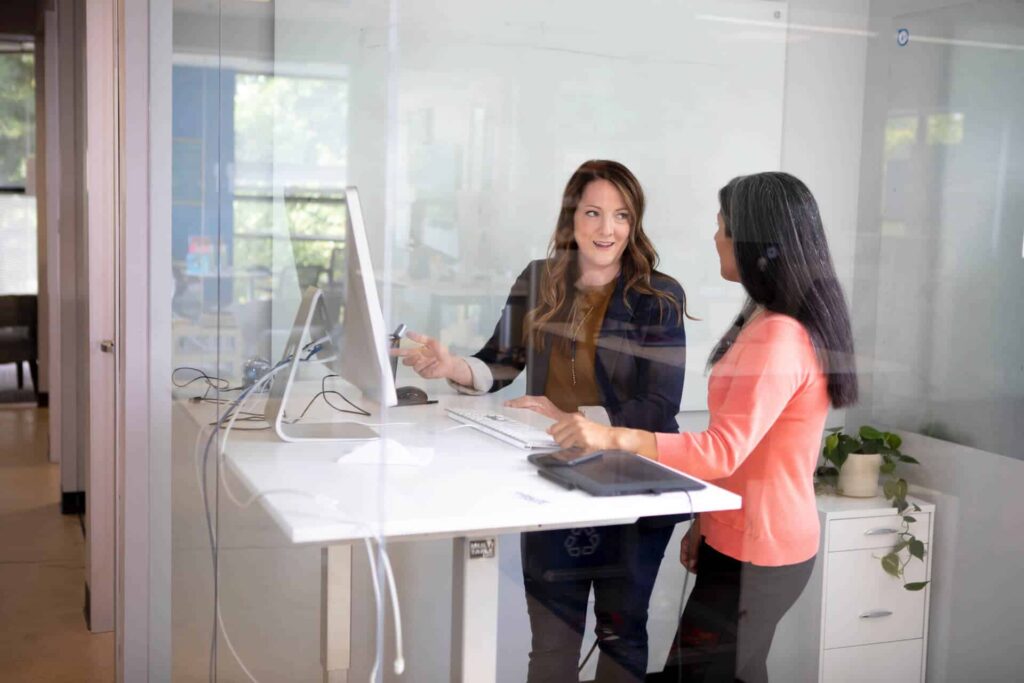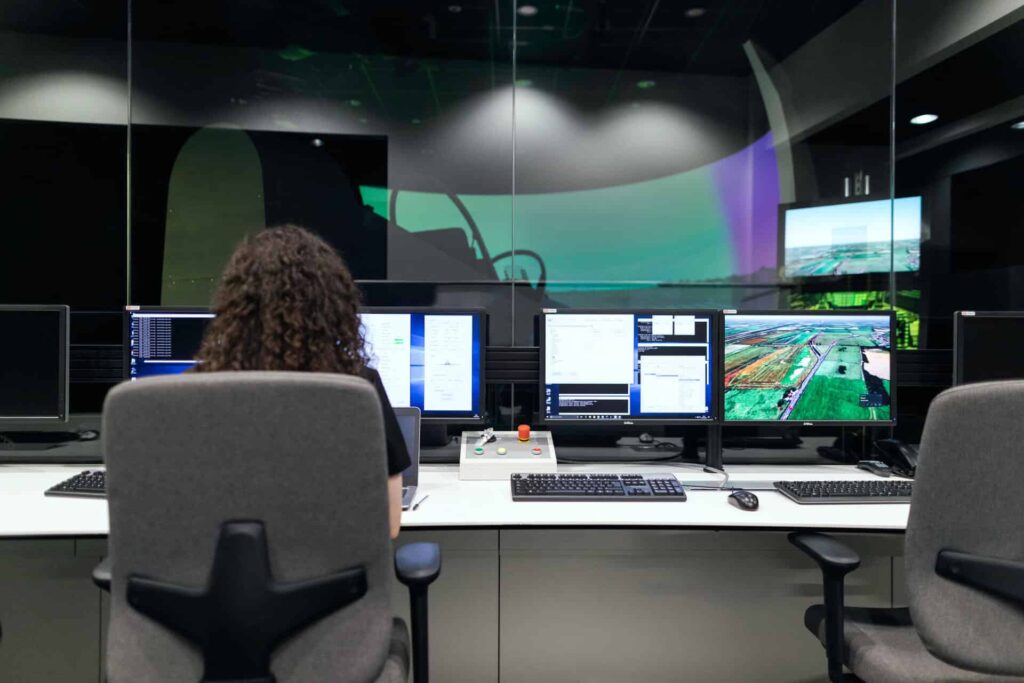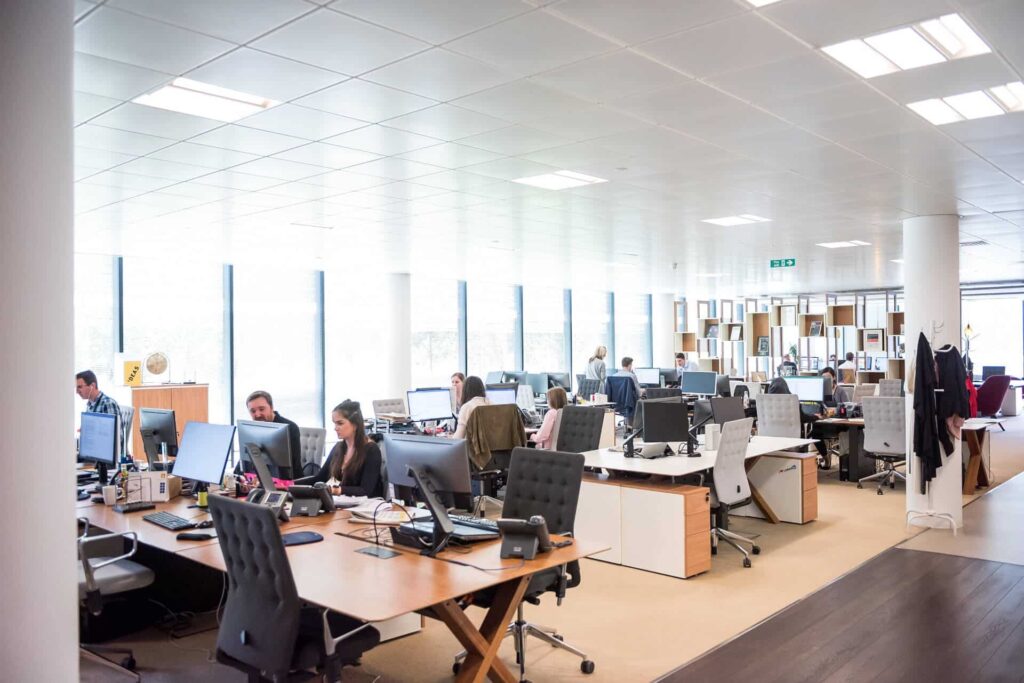Free addressing and sensors: Transforming flexible work
By David Spence• 5 mins read•October 21, 2021

Free addressing is an effective flexible workplace strategy that’s helping companies optimize their space while boosting employee engagement and productivity.
Particularly in the age of COVID-19, the use of sensors to manage the free address workplace protects the health and safety of employees. All without compromising on flexibility.
What is free addressing?
Free addressing is the practice of providing unassigned or shared workspaces, offering employees flexibility and choice of where they work.
With the use of sensors—an increasingly popular Internet of Things (IoT) technology—the status of free address workstations can be updated in real time. This allows employees to see which desks are available at any given moment.
There are lots of ways to manage and arrange the free address space, with office hoteling, activity-based working, and office neighborhoods proving popular options to optimize this flexible work strategy.

What is the difference between hot desking and free addressing?
Hot desking and free addressing are similar concepts. Both offer unassigned seating for employees to pick and choose where they work.
Hot desking typically refers to the traditional practice of offering shared desks on a first-come, first-served basis.
By contrast, free address desks can have a wireless sensor installed. This tracks when they’re occupied or empty, making it much easier to see what’s available and what’s in use.
In a hot desking scenario, an employee casts their eye around the space to figure out which desks might be free for them to use. If the space is big, they may need to wander around a while.
With free addressing and sensors—especially when integrated with an effective integrated workplace management system (IWMS)—employees can quickly and easily review the space to see which desks are available, without having to physically roam the whole office.

How does free addressing work?
An ideal free addressing system integrates sensor technology with an interactive floor plan like Visual Directory.
Employees can view the floor plan and see the status of each seat displayed in real time:
- Available (green): seat is available and ready to use
- Standby (yellow): seat is currently in use, but the employee is not physically at the desk
- Occupied (red): seat is in use and the employee is sitting at the desk
If a sensor detects that a desk hasn’t been in use for a while, it can automatically free up the desk based on a time limit. This can be pre-defined by the facility manager (FM).
The facility manager can also manage settings and preferences to keep desks showing as unavailable after they’ve been vacated. This can be for the purposes of cleaning, maintenance, and managing capacity.

What are the benefits of free addressing and live occupancy data?
More companies are recognizing hybrid work models as the future of work. As a result, facility managers are using free addressing and live occupancy analytics to make data-driven decisions. These decisions can have great operational and strategic impact.
With so many ways to use sensors in the workplace, the benefits are wide-ranging, and include:
Enhanced health, safety, and wellness
In pre-pandemic times, FMs might have considered potential turf battles or challenging noise levels to be the biggest drawbacks of hot desking or the free-address office.
Now, there’s a laser focus on the safety implications. For example, employees wandering through the space and occupying the same desk someone just vacated. Particularly if it’s in close proximity to someone else.
Sensors can help maintain workplace distancing and implement targeted desk sanitization. Both are important factors for safely returning employees to the workplace.
Desks that have just been vacated can be marked as off-limits on the floor plan until they’re cleaned. Similarly, desks can be marked as unavailable once a space is close to capacity. This is based on the live occupancy data provided by the sensors.
This automation of safety protocols takes pressure off the facility manager. It also enhances employee wellness by offering them peace of mind when entering the workspace.
Free addressing also more generally improves employee health and wellness, since it offers greater flexibility for remote and hybrid work options, and removes the potential stress of having to find a desk that sometimes comes with traditional hot desking.
Improved employee engagement and productivity
In addition to the benefits above, free addressing also enhances the employee experience and boosts productivity. This is due to the choice and flexibility it affords.
Particularly when integrated with office neighborhoods, free addressing offers employees a choice of work setting so they can match the work environment to suit their needs and mood.
Managing free addressing through an IWMS further enhances productivity and engagement. This is done through giving employees easy-to-use tools for viewing and booking their workspace.
When employees can quickly use their mobile to view available workspaces and make their selection, it contributes to a positive overall experience. They can also get straight to work, whether that involves booking into a quiet room so they can meet a deadline, or locating their team so they can huddle and collaborate on a project.
Evidence-based decisions about real estate
The partnership of free addressing and sensors offers facility managers and CEOs the evidence-based insights they need to effectively manage their space and real estate.
Knowing exactly how many desks are occupied at one time can help companies decide whether to stay in an existing space or expand to a new location.
For companies embracing hybrid work, precise analytics about how and when their desks are used can help them move away from traditional cubicles and private offices and implement free addressing effectively. This can help manage capacity, and avoid taking on more real estate before they truly need to.
Companies might also be able to sublet some of their space, based on what the occupancy data tells them.

Effective space and occupancy management
The real-time data generated by sensors removes the guesswork for facility managers. Especially when it comes to effectively managing a space without any assigned seating.
In addition to the real estate benefits above, sensor analytics can help facility managers reconfigure the existing space for maximum efficiency and productivity.
They can choose furniture styles, layouts, interior design, and positioning of supplies and facilities based on the most popular employee preferences they observe.
On the flipside, they can also zone in on the most underutilized open office areas. This can identify any issues with a particular type of space and make improvements that keep employees happy.
Sensors can also help minimize vacant or wasted space. They can cancel “no-show” bookings on workstations and meeting rooms, thereby freeing up this space for other employees to use.
Improved sustainability and energy efficiency
With sensors very much at the forefront of the evolution of FM software, companies are finding a variety of applications beyond space utilization.
Facility managers can leverage workplace sensor technology to help manage many aspects of the work environment, which relate to energy efficiency and sustainability.
Different types of sensors can control office lighting and adjust temperature. This is based on occupancy (how many people are in the space) and where they’re located.
The technology can also help monitor maintenance tasks and stock supplies. This way, a building is only consuming as much as needed.
Of course, this improved sustainability and energy efficiency also generates cost savings. And can make a company more attractive to prospective employees seeking a “green” employer.
Free addressing and sensors optimize the flexible workspace
From automation of flexible space booking, to making evidence-based decisions about real estate, to enhancing the employee experience—free addressing and sensors are an increasingly popular approach to flexible working in the modern workplace.
For more information and to keep track of the latest workplace trends, subscribe to the OfficeSpace blog.
Photos: gorodenkoff, LinkedIn Sales Solutions, ThisisEngineering RAEng, Laurence Dutton, Arlington Research



